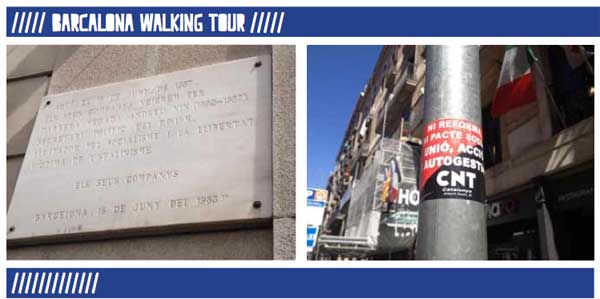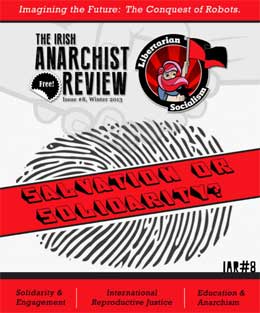Over 30 years of anarchist writing from Ireland listed under hundreds of topics
Shadows of a revolution - Nick Lloyd's Spanish civil war walking tour reviewed
Ask an anarchist for an example of a time and place where their ideas were put to the test and they will most likely reply with “Barcelona, 1936”. In July of that year, the workers of Barcelona, mainly organised around the anarcho-syndicalist Confederación Nacional del Trabajo (CNT; "National Confederation of Labour") rose in opposition to the fascist generals' coup that was gripping the south of the Spanish state.

Over the following months, the workers of Catalonia, guided by anarchist ideas, attempted to create a new society, based on the principles of solidarity, equality and mutual aid and fight a civil war against the generals, along side the forces of the republic, at the same time.
The tragedy that was the crushing of the revolution by the fascists on one side, and the Stalinist controlled state forces on the other, is well known to anyone with an interest in anarchism and revolutionary history. Nick Llyod's Spanish civil war walking tour, however, brings those events from the pages of our history books to life. The tour begins at Plaça Catalunya, where Nick, holding a copy of George Orwell's Homage to Catalonia, goes through the basics for those not so familiar with the various groups who took part in the conflict. He goes on to describe the events of the 21st of July 1936, when armed workers and the the civil guard prevented the fascist coup from taking Barcelona and the crucial battle at Plaça Catalunya.
Equality and Freedom
The next stop is at the site of the hotel on Las Ramblas, where Orwell stayed while he was not fight- ing at the front. Here, he reads a famous passage from Homage to Catalonia, describing the city under workers control.
“It was the first time that I had ever been in a town where the working class was in the saddle. Practically every building of any size had been seized by the workers and was draped with red flags and with the red and black flag of the Anarchists; every wall was scrawled with the hammer and sickle and with the initials of the revolutionary parties; almost every church had been gutted and its images burnt. Churches here and there were being systematically demolished by gangs of workmen. Every shop and cafe had an inscription saying that it had been collectivised; even the bootblacks had been collectivised and their boxes painted red and black. Waiters and shop-walkers looked you in the face and treated you as an equal. Servile and even ceremonial forms of speech had temporarily disappeared... Practically everyone wore rough working-class clothes, or blue overalls or some variant of militia uniform... Above all, there was a belief in the revolution and the fu- ture, a feeling of having suddenly emerged into an era of equality and freedom. Human beings were trying to behave as human beings and not as cogs in the capitalist machine."
Afterwards, he plays a recording of the CNT anthem, a las barricadas (to the barricades), and asks participants to squint as they look down las ramblas and imagine the scene described by Orwell. It is an emotional moment, if you are an anarchist, to feel like you are in the midst of social revolution, at a time where wealth and power has crumbled before a working class armed with libertarian socialist ideas (and guns of course). As you imagine the militias leaving for the front, while social relations are being transformed, a little sadness will grip you as you think of what happened afterwards.
Anticlerical violence
The next part of the tour deals with anti-clerical violence during the revolution. In front of one of Barcelona's many churches, while other tours consider the architecture and hear stories of the medieval city, Nick describes how the liberated workers took revenge on the catholic church, an institution that was firmly in league with the landowning classes and who had oppressed them for centuries. Despite the pleas for restraint from official CNT channels, churches were burned and many clergy were executed. We are shown images of workers dancing with their corpses that were used as pro-fascist propaganda in Ireland and other countries.
As the war raged on, the gains of the revolution were eroded, in part due to the compromises of the CNT leadership, participation in the popular front government and in part, due to the balance of power in Barcelona shifting to the Stalinists, who were now receiving supplies from the USSR. Nick describes the may days and other events that saw the return of capitalist social relations as we wind through Barcelona's narrow streets.
Days of darkness
The 1938 bombing of the city by Mussolini's air force is described in great detail. On the 18th of March that year, seventeen air raids took place at three hour intervals. The bombing wasn't restricted to military targets and the use of delayed fuse bombs devastated the whole city. Around a thousand died and two thousand were injured. You can still see bomb damage in the walls of some buildings. Photo's of the damage and casualties give you an idea of scale of this atrocity.
The final stops on the tour, deal with the defeat of the revolution and the fascist victory in the civil war. At a church we get to see a stone carving depicting “bad” workers destroying a church in 1936 and another depicting “good” workers rebuilding it in 1940. Finally, we return to las ramblas to the place where Andreu Nin, erstwhile Trotskyist and then leader of the left wing marxist POUM, who were allied with the CNT, was last seen alive before his kidnap and death at the hands of Stalinist agents. It is a poignant ending to a tour that takes us from the hope of 1936 to the dark days of the Franco regime's victory.
The tour then decamps to la libertaria, a bar run by the local CNT, where Nick gets a discussion going on the revolution and civil war and european politics today. Though, as Sergio, a member of the CNT told me, “Today, Barcelona is not the most important city for anarchism in the Spanish state, Madrid is the cutting edge of the class struggle”, it was the city where our hopes and dreams came closest to being realised. Nick Llloyd's tour is probably the best way to experience that today and if you go at the beginning of your visit, the rest of your holiday will certainly be enriched.
Words: Mark Hoskins
This article is from Irish Anarchist Review no 8 Autumn 2013


